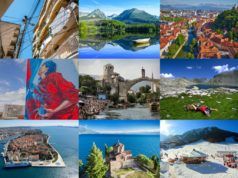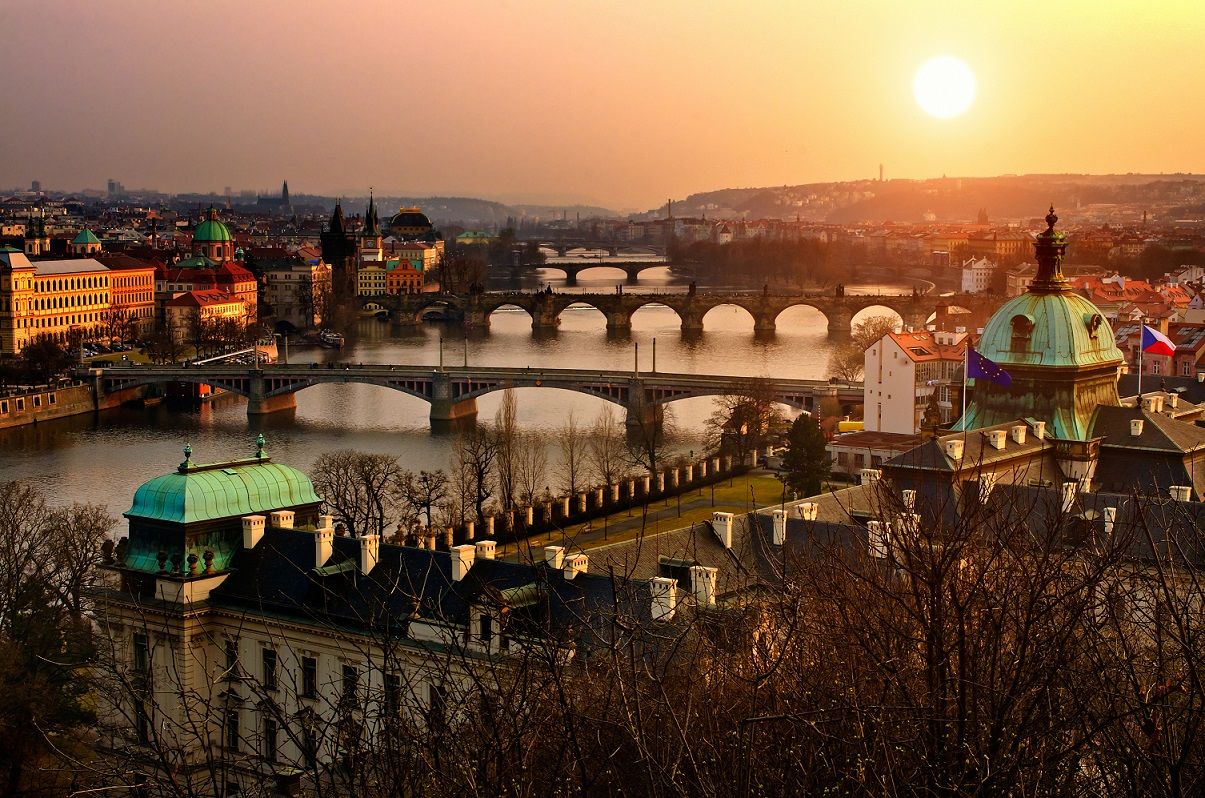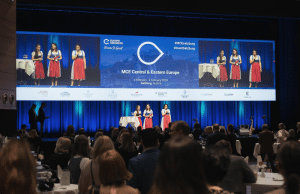LOW-CARBON INCENTIVE ISLAND
Mali Lošinj and Cres, the fragrant islands, are as magical in the winter as they are in summer. Viewed through the car windscreen, the gentle slopes towards the ferry port may seem innocuous, yet I remember how I once had to fight hard to conquer them on my bike with my ex-girlfriend and current wife. The special scent of the islands is also deeply embedded in my memory, the distinctive smell and variegation of the islands something that is always with me and always draws me back. Today, Cres and Lošinj are no longer only sun, sea and sand, but of late they have also been developing into a very interesting and sustainable incentive tourist destination. This has been the main reason to introduce the islands and their characteristics into this travelogue.
The islands of Cres and Lošinj used to be one land mass, but were separated into two islands by a man-made canal at Osor. Their oldest settlements are Lubenice, Beli and Osor. A long and turbulent history has left numerous traces on both islands. I spent several summers in the Juna Tavern, under the famous Valun Tablet, or rather its replica, where the first written words of the Glagolitic alphabet are carved, and cast my thoughts on the ancient Croatian culture.
Lošinj was settled in mid 13th century, developing into a leading regional naval force, navy captains from Lošinj still having a special reputation today. Their memory is preserved in the numerous historic buildings along the Lošinj Riviera. Lošinj has its favourable climate to thank for its tourist development, which first attracted Austrian pulmonary experts in the 19th century. In 1892 Lošinj was declared a climatic health resort, concrete proof of this status through the more than 1,200 plants on the island that have soothing effects on the respiratory system, scientifically proven way back in the 19th century. Soon after, a number of bed and breakfasts, sanatoriums and spas were constructed, and last year Lošinj celebrated its 125th anniversary as a health resort.
Cres and Lošinj have the most Karstic features of all the Croatian islands. They differ from other islands by the huge natural fresh water reserve at Vransko jezero. As a geography student the lake fascinated me, as it is an indigenous crypto-depression, the bottom of which reaches down to 61 metres below sea level. A tour of the lake and the nearby postcard village of Lubenice was a must for all curious geography students of the region. Geographically, the islands are heterogeneous, with a distinctive Mediterranean climate and a statistically-proven 60 cloudy days annually. The sea defines the islands and their natural characteristics: the eastern coast of Cres is an ornithological reserve where you can find the Eurasian Griffon near Beli and around Lošinj there is a protected area for dolphins. The underwater world around Unije and Susak islands is among the best preserved in the Adriatic.
The decision for sustainable tourism, for which Lošinj has received numerous awards, is therefore logical and based on the established sustainable products, preserved natural environment and concern for sustainable development. The conditions to develop sustainable and classic incentive programmes are extraordinary and offer numerous possibilities. Beautiful nature is everywhere and the commitment of the locals to sustainability is striking. This decision has been rewarded many times over and is fully justified, given the latent capabilities and potential of the islands.
The sea surrounding the islands both divides and connects. In terms of traffic, the biggest issues are ferries and other connections. Those through Valbiska and Brestova are satisfactory, albeit infrequent during low season. By road, the network throughout the 99km islands is predominantly upgraded and only in a few sections does it still remind me of the narrow, stone wall-lined roads of my youth. For sustainable travellers the only rail alternative is through Rijeka, which isn’t known for having the greatest connections to Europe. The islands have a small airport (with plans for an extension to the landing strip) where smaller propeller planes can land, an option suitable for smaller groups arriving via charter flights. If arriving by air you will also need to use imagination and ingenuity and consider connecting via nearby Rijeka and Pula, as well as Trieste, Ljubljana, Zagreb … – the islands are not easily accessible, however well worth the visit. Perhaps this symbolic isolation of the islands can preserve their sustainability and exclusivity, the islands only welcoming those who consider the voyage worthwhile.
Tourism is today one of the most important industries in Lošinj. High seasonality is the biggest issue: in the nineties a trip to Lošinj or Cres was a wonderful experience, as there weren’t many tourists. Intensive development started after 2001, which has now been reined in by sustainable strategies. The main tourist provider is the company Jadranka d.d., which currently manages seven hotels and five campsites. The other driving force of development is the main Lošinj ship-owning firm, Lošinjska plovidba, also active in tourism. A large proportion of tourist capacity is still absorbed in private apartments. While in the high-season and pre-season the island is full of excellent culinary and entertainment offers, in the low season it’s important to know the right spots and to arrange dining and entertainment in advance. Across all the tourist spots the offer of sports and recreation is plentiful. The island is also known for its cultural festivals, all of which is wonderfully connected by the local Lošinj tourist organisation under the slogan “Island of Vitality”.
Since the renovation of the hotels on Mali Lošinj, the summer season-oriented facilities are now turning towards the meetings industry. The island remains relatively unknown in the field, despite the extraordinary natural conditions it offers for the meetings industry. The Čikat and Sunačni Bay areas hold almost all of the Lošinj congress capacities, the flagship of the offer being the renovated congress and wellness hotel, ‘Aurora’. The multi-function hall, with its view of the pine tree forest, can seat up to 400 people. Besides that it also offers several smaller meeting rooms and an additional hall for 110 people in the adjoining Hotel Vespera. The hotels have a combined 797 rooms, complemented by a rich culinary offer. The ratio of congress capacities to rooms is suitably and sustainably balanced, with most of the congress offer managed by the company Lošinj Hotels & Villas. Further congress capacity is available at Hotel Bellevue, its largest hall accommodating 220 people, with the same owners facilitating the organisation of events. The personnel of these hotels are very hospitable and strive to ensure that guests are satisfied with all aspects of their service. Next year the renovated Hotel Punta will open under the new name ‘Club Hotel Punta’. With this well rounded and renovated hotel offer, Lošinj is well positioned to become one of the boutique and sustainable congress and incentive destinations in the Adriatic.
The strongest elements of the congress offer are nature, climate and the energy of the location, one that offers numerous possibilities for sustainable incentive programmes. The island is a true epicentre of possibilities, many of which are still unexplored. A journey through these can start in the north, at the ‘Eco’ research-educational centre in Beli, where you can learn about preserving natural and cultural heritage and protecting the Eurasian Griffon. Congress guests can become volunteers and help out at the centre. Nearby there are the Osiris, Lada, Tara and Ishtar labyrinths. The historic ‘Valun’ can be the venue for a treasure hunt and there are culinary stories to be told at Toš. Lubenice, with its history and wonderful architecture, is now like a labyrinth, almost deserted. Around Cres there are a number of condensed olive plantations, which can play a part in incentive story-telling. Osor is called a ‘museum city’, lending itself to cultural incentive stories. The climb to Osorščica can become an orientation trek for a smaller, adventurous group. You can paddle a sea kayak from Lošinj to the nearby islands of Ilovik, Srakane or Silba. In Veli Lošinj you can become familiar with the project protecting Lošinj dolphins in the Maritime Educational Centre. Lošinj and its surroundings are the ideal starting point for thematic, historical, adrenaline-filled and eco team building as well as the classic, water-borne team building activities.
The current disadvantage of the island is its lack of specialised congress agencies. Only traditional tourist agencies deal with the meetings industry and, occasionally, the hotels themselves. This is a major unexploited business opportunity. As a result, incentive programmes are developed mostly for the leisure tourist and haven’t reached the level of a highly developed product, yet all other support services are developed and can certainly facilitate the organisation of events. Also, due to a lack of suppliers and development there is no Convention Bureau, its function being carried out by the small team of TZ Lošinj. In this area the island certainly needs a strategy and targeted marketing, because this is one of its opportunities in the low season.
Spiced up by the long years of tourist tradition and solid business-mindedness, the renowned hospitality of the locals is a good starting point for the development of the sustainable meetings industry. The ratio of quality to price is excellent in comparison with other more famous islands. The island’s weakness, however, can be ascribed to its non-existent image to the meetings industry, something that can be a huge opportunity for all wishing to take advantage of its immense potential. The personal experience is certainly positive; I am a fan of autumnal serenity, when the islands breathe and seem more peaceful. Cres and Lošinj are the perfect islands for all seasons.
Destination mark: 3.35 – recommendable meetings destination
Marks:
5 excellent meetings destination
4 quality meetings destination
3 recommendable meetings destination
2 average meetings destination
1 passable
Individual marks:
- Natural and cultural factors 4.5
The diversity of the islands, the climate, vegetation, culture, architecture and the incredible marine areas are ideal for incentive and congress products. The natural environment is very well preserved, dolphins living in the waters around Lošinj are a clear testament to this. The natural and cultural factors are ideal for incentive programmes. - General and transport infrastructure 2.9
The general accessibility of the Kvarner Bay has improved in the last few years. Access to the islands is still problematic, even though they are not quite as isolated as other Dalmatian islands. The entire Kvarner area has bad air connections and the renovation of the airport on Krk is a precondition for intensive development of the meetings industry. - Tourism infrastructure 3.8
The tourist infrastructure of Lošinj and Cres has been developing for 125 years and is of a great standard. The offer of recreation and sports is extraordinary, as well as the culinary offer and destination management. The islands are missing some boutique offers for the more demanding guests, the existing hotel offer could also be complemented with some high-level hotels. - Meetings infrastructure 2.9
New congress capacities at the Aurora and Vespera hotels lifted the potential for organising congresses. In general, the product lacks the developed incentive programmes carried out by specialised agencies. To date the offer is disconnected and would benefit from strategic, coordinated action. - Subjective assessment 3.6
The islands of Lošinj and Cres are sustainable diamonds amongst the coal. Of the 1244 officially recognised Croatian islands they possess excellent natural conditions and are authentic and packed with diverse adventures, all of which contributes to a positive personal experience. The meetings industry is not in a prime position yet, but I am certain it will soon become a part of the sustainable strategy of the islands’ tourism.
Comparison to the Region:
Lošinj and Cres are the only Adriatic islands that successfully deal with sustainable tourism and are amongst the more eco-friendly islands of Kvarner. They differ from the more famous Dalmatian isles, such as Hvar, Brač and Krk, with their nature preservation, systematic sustainable development and cultural heritage. All these activities are well managed and present a huge opportunity for the development of a limited and exclusive sustainable meetings industry in harmony with the capabilities of the islands. The key challenge is the invisibility of the islands’ image on the meetings industry radar, lacking the recognisable incentive brands to build the high quality boutique and intimate stories that can raise its profile. If local suppliers can develop from these points and their programmes can continue to be socially responsible, they will be able to benefit from the current trends in the industry. I am certain their first clients will be the existing loyal guest of Cres and Lošinj. With a high added value the islands can also become the eco-incentive oasis of the Adriatic.
Cool meetings:
Healthy Mediterranean cuisine pervades Cres and Lošinj – fish from the baker’s oven; brodet with polenta and other sea food with fresh ingredients; baked lamb from Cres that is equally as good as anything in Pag. Everything is available in typical taverns, alongside the few top restaurants at the upper end of the Croatian offer. The spices and herbs are a symbol of the islands, so a visit to Lošinj’s Miomirisni vrt herb garden is highly recommended.

























